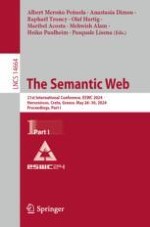2024 | Buch
The Semantic Web
21st International Conference, ESWC 2024, Hersonissos, Crete, Greece, May 26–30, 2024, Proceedings, Part I
herausgegeben von: Albert Meroño Peñuela, Anastasia Dimou, Raphaël Troncy, Olaf Hartig, Maribel Acosta, Mehwish Alam, Heiko Paulheim, Pasquale Lisena
Verlag: Springer Nature Switzerland
Buchreihe : Lecture Notes in Computer Science
